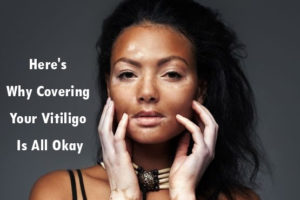
Be it any skin color, dark, fair, or any shade in between, most have skin with the same tone across the body. But, the case is different for those with Vitiligo.
Vitiligo in detail
Vitiligo is a skin condition in which a person starts to lose skin pigment, causing patches or white spots to develop on the skin. It isn’t a medical condition, and it is known to affect every race, but mostly kids and teens. Vitiligo is not an infection or a kind of skin cancer, and it’s not a contagion, so there are no chances of catching it from another person. People with Vitiligo are as healthy as people without Vitiligo.
What happens in Vitiligo?
Cells called melanocytes determine the skin color of a person. It is not the number of melanocytes that decide the color of a person, as all are born with the same number; rather, the skin color depends on how active the melanocytes are. People with dark-skin have melanocytes that produce a lot of melanin, and the opposite happens for those with light skin, i.e., melanocytes produce less melanin.
It so happens that the skin of people with Vitiligo, whatever be the shade, stops producing melanin all of a sudden. At first, it might only appear as a small lighter patch on the skin, called a macule, but with time, the spot would spread and start growing to affect a more substantial portion of the body.
Although all races of people can be subjects to Vitiligo, the lighter spots or patches tend to be easily visible on those with darker skin.
The three types of Vitiligo
Depending on the number and location of patches found on the body, there are three types of Vitiligo.
- Focal Vitiligo: A person with this Vitiligo has few spots in one area of skin.
- Generalized Vitiligo: This is the most common type in which the person tends to show white patches on both the left and right sides of the body, like a mirror image, owing to its symmetrical pattern.
- Segmental Vitiligo: In Segmental Vitiligo, the person shows spots or patches, only one side of the body. It is a rare type of Vitiligo.
Vitiligo can occur on any part of the body, but it has known to appear mostly on,
- Those areas which are exposed to the sun, including face and hands
- Those areas with folds, such as the region of elbow, groin, or knees
- Those areas surrounding the nostrils, eyes, belly button or genitals
Apart from giving color to skin, melanocytes also decide hair color, and so some people with Vitiligo might notice strands of gray hair or pale lips.
Vitiligo Causes
Experts and scientists can’t quite put their finger on what causes Vitiligo, but they have a few theories to share. One theory explains that it’s probably the immune system accidentally attacking and striking healthy melanocytes. Some suggest that it could be genetic.
Scientists conclude the following as risk factors for developing Vitiligo.
- Thyroid disease
- Diabetes
- Alopecia (an autoimmune disorder causing hair loss)
How is Vitiligo Diagnosed
A look at the telltale white patches is enough for a dermatologist to conclude whether it’s Vitiligo. On those with light-skin, the doctor might use a Woods Lamp in a dark room, for its ultraviolet light can illuminate damaged skin, otherwise invisible to the naked eye.
Treatment
As of now, Vitiligo has no medical cure. You can try out the following to take care of your Vitiligo at home:
- Use sunscreen: Invest in a good screen and make sure that you use it daily. Vitiligo patches have no melanin pigment, so they can’t tan. But, if the affected patch isn’t covered with a sunscreen, then there are increased chances of the spot getting burnt or scarred. Besides, getting a tan on the rest of the body might inadvertently result in highlighting the patches, especially for those with light skin.
- We recommend cosmetics: Try out different brands of concealers until you find the right one that works for you. You can even ask your dermatologist for suggestions.
Live your life to the fullest.
It’s essential to come to terms with the fact that Vitiligo isn’t a life-threatening disease or a disease at all. It depends on your outlook and how you carry yourself. You can cover up your Vitiligo, but you must live your life to the fullest. Don’t let insecurities keep you behind and cheat you out of the fun you can have with your friends and family. Give yourself the occasional pep-talk that you are so much more than a faded layer of skin. Don’t let Vitiligo define you; let your dreams and desires overtake your Vitiligo and represent you, once, and for all.